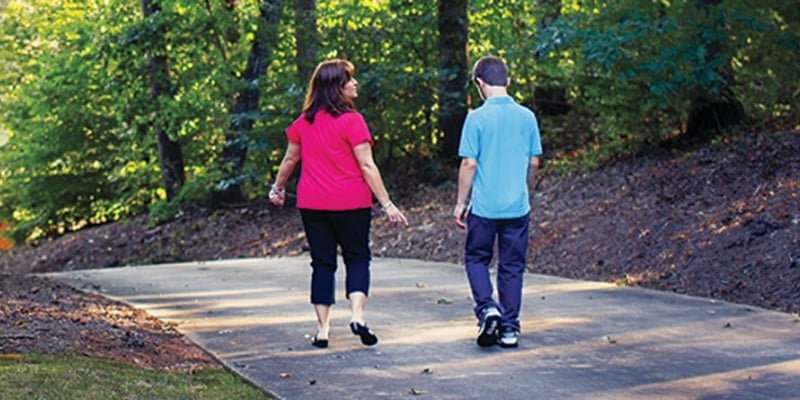Caregiving: The Power of 2
Caregivers play a central role in the life of a loved one with epilepsy. Not only do they help manage seizures, medications and doctor appointments, but they can also offer emotional and moral support and advocate for the loved one in the community. We talked with a few caregivers and patients about what’s worked well for them, including launching a child with epilepsy into adulthood, paying attention to everyday details like stress and sleep, and navigating boundaries. In the end, however, these stories have a running theme: Two are better than one.
Teaching Teens Leadership
Amy W. and her son, Spencer, are like an epilepsy advocacy army of two. Every year, she and Spencer organize fundraisers during National Epilepsy Awareness Month to provide scholarships to a summer epilepsy camp. The two of them have presented a number of educational programs, and they’ve participated in the National Walk for Epilepsy as well as their local Epilepsy Foundation Walk for many years. On many occasions, they have taken Spencer’s seizure-response dog to school.
“One of our goals was to empower Spencer,” says Amy. “We wanted him to feel as though he were chosen to guide the way for others, rather than consider himself a victim.” Advocacy work has helped Spencer gain a sense of purpose and develop leadership skills. Now 16, he’s taking on new responsibilities. After three years attending a summer epilepsy camp, Spencer returned last year as a leader-in-training.
Amy is also teaching him to tell his own story. “When he goes to college he’ll be meeting with professors and disability services to ask for accommodations for classes,” she says. “He has to be able to advocate for himself and tell them what his needs are.”
Recently, she and Spencer met with his new high school teachers, and for the first time, she let Spencer do all the talking. “He did the entire meeting on his own—that moved from me to him, this year.”
She’s begun doing the same thing at doctor appointments. Getting Spencer to address new medical needs can be a challenge; he has such a positive attitude that he hardly wants to tell the doctor when something is wrong. Of course, this is where a caregiver can help. “We’re working on that,” she says.
Letting Go of Young Adults
At age 27, Alyssa K. is seizure-free, has her driver’s license, can cook some meals and manages her own finances. She still lives at home, but mostly because she is launching a freelance graphic design career and working her way into the surface-pattern design industry.
Her mother, Shelley K., began to give her a taste of independence at 18, when Alyssa enrolled at the local community college. She’s been gradually coaching her to take on more since then. Though it was hard letting go, says Shelley, it was a good first step. Alyssa soon became an Epilepsy Advocate and was giving speeches to rooms of dozens of people. “It gave her a ton of confidence,” says Shelley.
After community college, Alyssa got a degree at a university, where she lived in a dorm, completed her assignments on time, and advocated for herself with the Disabilities Office and with her professors. Shelley opened up a checking and savings account for Alyssa and, through the bank, got her a credit card. Alyssa now independently pays her own bills and manages her bank accounts.
Her road to independence feels nearly complete. “I’m getting closer to catching up, getting lined up with everyone else,” Alyssa says.
Close Caregiving for a Spouse
In the 30 years they’ve been married, Jesse B. has learned to become very familiar with his wife’s seizure triggers and warnings. But Michele’s epilepsy is also evolving. As she gets older, everyday stressors are more likely to cause a seizure, he says, and the seizures take more of a toll. That means they pay more attention to heat, the environment and how much sleep she gets. He checks on her by phone three to five times a day.
“I try to be attentive to the little things,” he says. “If somebody invites us to go do something, I try to ask more questions up front. How long is the event going to be? Where’s it at?”
Even though she rarely goes anywhere on her own, Jesse says, “I’ve always tried to let her feel just like anybody else.”
Managing Boundaries: Caregiving for a Father
Two decades ago at age 35, Chris M. was diagnosed with encephalitis. At the time, he was a married pastor and sports coach with three young sons. His illness led to seizures, short-term memory problems and a major personality change. Suddenly the leader needed to be led. Together, his wife, Debbie, and his boys Taylor, Aaron and Graham—then aged 11, 9 and 6—had to teach Chris how to take care of himself again.
Chris says one of the hardest things is learning to navigate boundaries. “I wanted their help, but I didn’t want their help,” he says. “When I went to see a counselor, that showed me the value of their assistance.” Together he and his family ultimately worked out a good balance with the support of his wife’s parents, family friends and Chris’s congregation.
Taylor, the eldest son, played a major role tending to his younger brothers as they all worked to keep the house running. All three helped Chris remember the names of longtime friends and members of the congregation with subtle little tricks. They also taught him to use technology to aid his memory for public speaking and other tasks.
Today, the kids are all grown. “Now they’re all leaders,” says Chris. “You look back, and it’s like, would they be so good at doing what they do if they hadn’t gone through that?”
Originally printed in EpilepsyAdvocate, Fall 2016.
Categories : From Our Magazine
Tags : Blog





